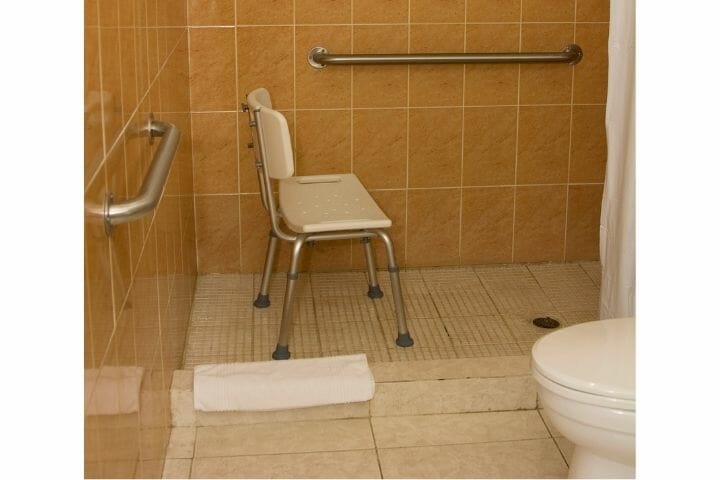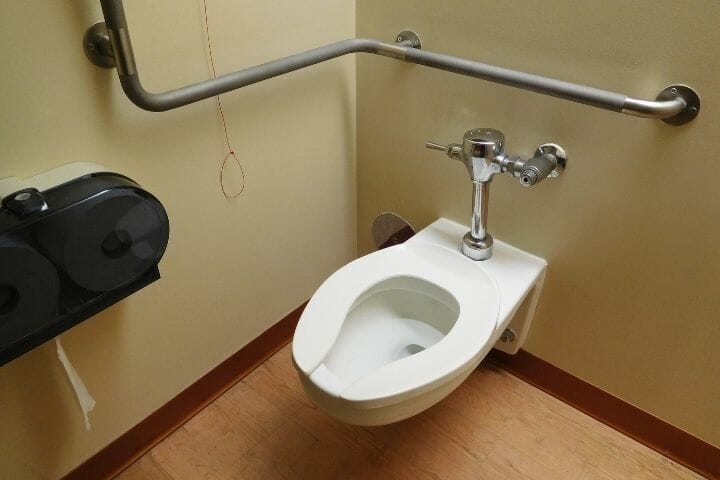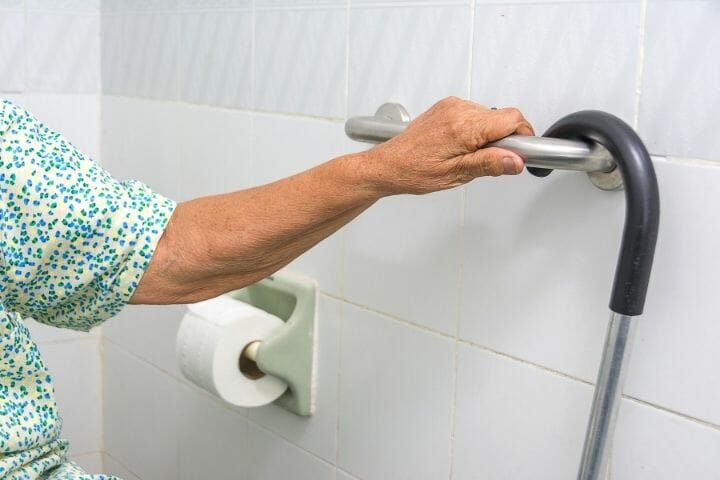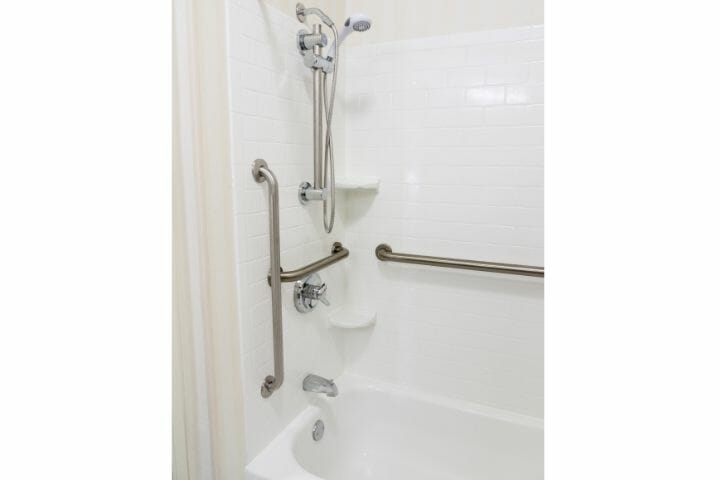Grab bars are essential equipment necessary for the disabled and elderly to support themselves in places like public washrooms. This article details the ADA requirements for grab bars in public places.
Contents
Americans with Disability Act or ADA is a civil rights act that became law in 1990. The law ensures that disabled people get the same opportunities and rights as non-disabled people. ADA prohibits any discrimination in public life with disabled people in the USA. ADA is not limited to public spaces; it is also applicable in specific private spaces.

After the Anti-disability law, all public spaces have to have specially designed amenities for the disabled. ADA made standards for public constructions so that disabled people can use public facilities. The constructions should have ramps, grab-bars, and other supporting elements for effortless accessibility to disabled people.
ADA covers the comfort of disabled people and makes sure that disabled people do not get discriminated against in private jobs, schools, and government services. The ADA is a small step in making the world easier for disabled people. The government is now more answerable to the needs of disabled people.
Today, we will tell you about the grab-bar requirements of ADA. The law has pre-decided the standards for grab-bars on bathrooms, toilets, showers, and general structures. The special guidelines are also applicable to public transport. We will explain each one of them in detail, so you can design or renovate your place while fulfilling ADA standards.
General Requirements of Grab-bars
Grab bars have different standards for amenities like bathrooms, toilets, bathtubs, and showers. In general, the grab-bars should be horizontal and have an easy to hold design for everyone.
According to ADA, if someone has circular grab-bars, they should have a 1.4-2 inches diameter. Non-circular bars should have a cross-section area of 2 inches, and the bar’s radius should be 4-4.8 inches.
The bars should be separated from the walls by at least 1.5 inches so that everyone can hold them easily. If there are any projecting surfaces on the bars, they should also be at a space from the walls for convenience.
If objects are at the end or below the bars, they must be 1.5 inches away. The requirement is 12 inches above the top of grab-bars for above the bar objects.
Exceptions for the above measurements are applicable for showers controls; grab-bars are allowed to be 1.5 inches away there. The installed bars cannot rotate in their place, as rotating grab-bars can cause accidents. The bars should have a polished and round surface to avoid any injury-causing surface chipping. There is also a weight holding standard for the grab-bars; they must hold at least 250 lb.
There are few exceptions to ADA requirements in amenities. If the bathroom is made for individual use and not public use, grab-bar installation is not mandatory. However, grab-bars on walls are necessary for additional support in the future. In prisons, grab-bars are not allowed in suicide prevention cells.

Toilet Grab-bar Requirements
ADA has set specific positions for grab-bar installation in public toilets and small bathrooms. A bar should be alongside the toilet wall; a bar should be behind the toilet for better support. The bars should be at 33 to 36 inches above the tiled surface of the bathroom.
The length of the sidebars should be at least 42 inches. One end of the bar should be at 12 inches at maximum from the wall behind the toilet. The grab-bars behind the bathroom should be 36 inches; they must be in centerline with the toilet seat.
If there are recessed fixtures next to the toilet or a flush handle at the rear of the bathroom, the bar can be 24 inches in these conditions. If the length of the bar conflicts with the flush handle, then the bar can be split in half to make things easy. There is also an option of moving away from the grab-bar.
All of the requirements that we are telling you about are for adults. There are separate ADA requirements for children’s toilets.
Grab-bar for Children’s Toilet
The grab-bar requirements for children’s toilets are logically different from adults’. ADA made the norm of height to be at 18-27 inches from the surface of the bathroom.
- For 3-4 years old children, the grab bar should be 18-20 inches.
- For children aged 5 to 8-year-old, the grab-bars requirement is 20-25 inches.
- For nine years and above, grab-bars should be 25-27 inches.
However, you can tweak these numbers for the disability level of a child and put grab-bars according to it. ADA had taken accounts of the average of social experiments conducted to arrive at these numbers. For other related requirements, you should visit the official ADA page.
We have told you about the grab-bars requirements in toilets; we will now tell you about the ADA requirements in other public or private amenities.
ADA Requirements for Showers and Bathtubs
ADA has set standard requirements for grab-bars on showers and bathtubs, keeping in mind the comfort of disabled folks. The law has made it compulsory for public and private spaces to design at least one bathroom with ADA requirements especially.
Requirements for Bathtubs
Grab-bar conditions are different for seated and non-seated bathtubs. Most of the rules for grab-bars on the bathtubs are the same as those on toilets. Bathtubs with seats require a grab-bar on the rear wall and control wall.
Two bars are compulsory on the back wall. One should be 8-10 inches above the bathtub’s rim; the other should be parallel to the bathtub 33-36 inches above the floor. The control end bars should be 24 inches long and at the front edge.
Bathtubs without seats should have back and control wall grab-bars. The rear wall grab-bar can be the same height as seated bathtubs, but the length should be 24 inches. Other than the back wall, grab-bars are also mandatory at the control and head-end walls.
The control wall bar can have grab-bars of 24 inches or longer, while the head bar should be at least 12 inches.

Requirements for Showers
There are two ADA compliant showers, roll–in and transfer showers. Transfer showers are for those who have mobility and can carry themselves to the shower, while the roll-in showers are fit for those who do not have any mobility.
The grab-bars on transfer showers should be 33-36 inches above and hold 250lb (like toilets). If there are multiple bars, they all should be at the same height as the shower. Grab bars should be 18 inches away from the control bars.
Roll-in showers need bars on the wall opposite to the seat and on the back of the seat. But you cannot install grab-bars above the seat. If the shower has no seats, one should put grab bars on all three walls 6 inches away from perpendicular walls.
Roll-in showers have a unique design to accommodate the wheelchair of the person so that he does not need to get up. Other than roll-on, there is an alternative roll-on shower with short walls on the front of the shower. The requirements are slightly different from roll-on showers.
Do You Need to Follow ADA Guidelines In Your Residence?
This is a general question that most landowners have while constructing their houses. The answer would be no; you do not need to follow the ADA guidelines word for word. However, the ADA guidelines provide you with safety standards for your bathrooms and toilets.
The guidelines will give you an idea of the best height to install grab-bars to avoid a fall. If you do not want to follow ADA guidelines, you can keep these few things in your mind to better design bathrooms and toilets.
Consider Physical Needs
While installing the grab-bars, you should take note of the heights of home occupants. Put yourself into the shoes of all the occupants and find out what will be the best place to install a grab-bar.
If you install grab-bars at the wrong height, the falls will be in-evitable. You can use angled or vertical bars rather than horizontal grab-bars for better results.

Fulfill Aesthetic Needs
People often find it less appealing to put grab bars as they clutter the beauty of their bathrooms. But there are many stylish grab-bars available in the market that can take away this worry.
Designer curved bars, zigzag grab-bars, and swing-up grab-bars are the few options you can choose. All of these bars will provide you a stylish look with safety. All you need to do is install the grab-bars at an optimum place.
Conclusion
ADA has done tremendous work in safeguarding the rights of disabled people. The law gave them an opportunity to be treated at par with their non-disabled peers. Under the ADA, particular guidelines are now in the public domain to design disabled-friendly public amenities.
The law is not limited to government buildings but covers some privately owned properties. The ADA sets the requirements of grab-bars for Toilets, showers, and bathtubs. Etc. The standards ensured that disabled people had maximum comfort in using the facilities.

Non-compliance with ADA guidelines in public and private properties is a punishable offense. However, you can avoid ADA standards in your residence and install the grab-bars according to your comfort.
We hope that you found the above information useful and would like to follow some of these guidelines while constructing your own washroom. If you have any questions regarding ADA guidelines for grab bars, you are welcome to post a comment and we will respond with the correct answer.
Do please share this article with others for better reach on your social media platforms and groups.
